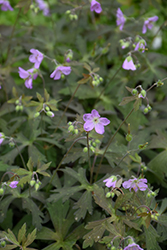It's all about ...
plants

Crane Dance Cranesbill
Geranium maculatum 'Crane Dance'
Height: 28 inches
Spacing: 28 inches
Sunlight:
![]()
![]()
Hardiness Zone: 4a
Other Names: Wild Cranesbill, Spotted Cranesbill
Description:
This is a compact clump forming perennial with unusual chocolate-brown foliage, turning bright red in the fall; vibrant blue, saucer-shape flowers contrast boldly with the foliage in late spring to mid-summer
Ornamental Features
Crane Dance Cranesbill has masses of beautiful clusters of violet bell-shaped flowers with blue overtones rising above the foliage from late spring to mid summer, which are most effective when planted in groupings. Its attractive deeply cut lobed palmate leaves emerge light green in spring, turning grayish green in colour with showy dark brown variegation. As an added bonus, the foliage turns gorgeous shades of red and in the fall.
Landscape Attributes
Crane Dance Cranesbill is an herbaceous perennial with a mounded form. Its relatively fine texture sets it apart from other garden plants with less refined foliage.
This plant will require occasional maintenance and upkeep, and should only be pruned after flowering to avoid removing any of the current season's flowers. Deer don't particularly care for this plant and will usually leave it alone in favor of tastier treats. Gardeners should be aware of the following characteristic(s) that may warrant special consideration;
- Self-Seeding
Crane Dance Cranesbill is recommended for the following landscape applications;
- Mass Planting
- General Garden Use
- Naturalizing And Woodland Gardens
- Container Planting
Planting & Growing
Crane Dance Cranesbill will grow to be about 24 inches tall at maturity, with a spread of 32 inches. When grown in masses or used as a bedding plant, individual plants should be spaced approximately 28 inches apart. Its foliage tends to remain dense right to the ground, not requiring facer plants in front. It grows at a medium rate, and under ideal conditions can be expected to live for approximately 10 years. As an herbaceous perennial, this plant will usually die back to the crown each winter, and will regrow from the base each spring. Be careful not to disturb the crown in late winter when it may not be readily seen!
This plant does best in full sun to partial shade. It prefers to grow in average to moist conditions, and shouldn't be allowed to dry out. This plant should not require much in the way of fertilizing once established, although it may appreciate a shot of general-purpose fertilizer from time to time early in the growing season. It is not particular as to soil type or pH. It is somewhat tolerant of urban pollution. This is a selection of a native North American species. It can be propagated by division; however, as a cultivated variety, be aware that it may be subject to certain restrictions or prohibitions on propagation.
Crane Dance Cranesbill is a fine choice for the garden, but it is also a good selection for planting in outdoor pots and containers. It can be used either as 'filler' or as a 'thriller' in the 'spiller-thriller-filler' container combination, depending on the height and form of the other plants used in the container planting. It is even sizeable enough that it can be grown alone in a suitable container. Note that when growing plants in outdoor containers and baskets, they may require more frequent waterings than they would in the yard or garden. Be aware that in our climate, most plants cannot be expected to survive the winter if left in containers outdoors, and this plant is no exception. Contact our experts for more information on how to protect it over the winter months.
This plant is not reliably hardy in our region, and certain restrictions may apply; contact the store for more information.
